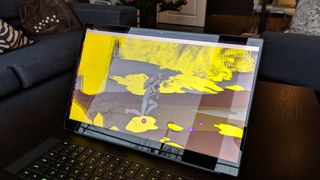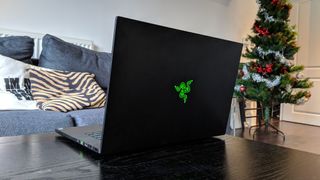IT Pro Verdict
Essentially by accident, Razer has created an exciting substitute for the usual mobile workstation fare. Though its graphics processor and hexa-core CPU were intended to run games, these components can be harnessed for productivity too – and for much less cash than a high-spec MacBook Pro.
Pros
- +
Powerful graphics capability; High build quality; Robust connectivity
Cons
- -
Low battery life; Storage slow by PCIe standards

The Razer Blade 15 (2018) open on a table

The lid of the Razer Blade 15 (2018) with the logo visible

Close up of the Razer Blade 15 (2018) keyboard and trackpad

Close-up of the ports on the right-hand side of the Razer Blade 15 (2018)

The Razer Blade 15 (2018) open at the login screen

The Razer Blade 15 (2018) running a rendering workload

Close-up of the ports on the left hand side of the Razer Blade 15 (2018)
Like the vast majority of Razer's output, the Blade 15 is made for gaming - and pretty serious gaming too, judging by its dedicated 8GB Nvidia GeForce GTX 1070 Max-Q graphics processor and hexa-core Intel Core i7-8750H.
Still, could such muscular hardware give it a second life as a mobile workstation? It's certainly an interesting prospect, as even this top-of-the-line 4K model we've been using is thousands of pounds cheaper than the 15in MacBook Pro model we tested last year. Drop down to one with a more equivalent 16GB of RAM and 512GB SSD, and Apple's laptop is still a lot more expensive at 2,474 before tax. The 2,050 Blade 15, therefore, could be a canny alternative.
Razer Blade 15 (2018) review: Design & connectivity
The 2.1kg Blade 15 is heavier than the 15in MacBook Pro, which weighs 1.83kg, though by gaming laptop standards this is one of the more portable ones. It's also a couple of millimetres thicker, at 17.3mm when closed, though the upside is a far better selection of ports than the MacBook Pro.
Whereas Apple's design relies solely on four USB-C ports and a headphone jack for data, video output and peripherals, the Blade 15 serves up three full-size USB 3.1 ports, a Thunderbolt 3-enabled USB-C port of its own, a full-size HDMI output, a mini-DisplayPort and a headphone jack. It's clearly more readily-equipped for things like mice, external hard disks and desk monitors, with much less need for a cumbersome dock.

Strangely, there's no Ethernet port on this 4K model, unlike the 'Basic' 1080p version of the Blade 15, but it still supports 802.11ac Wi-Fi and Bluetooth 5.0.
It's a well-made laptop overall, with a solid-feeling aluminium chassis and a firm hinge - and, as opposed to a lot of gaming laptops, it's smart enough aesthetically to use in an office without getting strange looks. It's only really lacking a fingerprint reader, though it's also worth noting that there's nothing directly comparable to the MacBook Pro's TouchBar controls.
Razer Blade 15 (2018) review: Keyboard, trackpad & touchscreen
That said, you do get touchscreen capability - which works well enough - plus something else the MacBook Pro doesn't have: full RGB backlighting for the keyboard. More importantly, Razer has done fine work with the keyboard's general usability: the chiclet keys are nicely sized and spaced, and key travel is noticeably deeper than on the MacBook Pro. This is partly down to intentional design choices on Apple's part - the MacBook Pro favours a lighter actuation force over travel depth - but we do feel that the Blade 15's keyboard is easier to get used to.
The trackpad is smaller than the MacBook Pro's gargantuan pad, but is still comfortably proportioned for the 15in screen. Its smooth texture and general responsiveness are easy to like, too. Although this is a clamshell-style laptop and not a convertible, we also found it quite natural to flick between touchscreen and trackpad inputs.
Razer Blade 15 (2018) review: Display
Touchscreen tech does bump up the price, as does the 3,840 x 2,160 resolution, but the latter's upside is a much higher pixel count than the 15in MacBook Pro. The Blade 15's contrast, which we measured at a high 1,486:1, is higher too.

Otherwise, Apple's laptop performed better in most of our tests. The Blade 15's peak brightness of 397cd/m2 and rather high average delta E of 4.45 both come up short of the MacBook Pro, which also covered 99% of the DCI-P3 gamut, whereas the Blade 15 covered 88%. Knowing this, and the Blade 15's lower colour accuracy, the MacBook Pro's would likely serve better for photo and video editing even with its lower resolution.
That said, the Blade 15 hardly looks bad. It covers 99.4% of the narrower sRGB colour gamut, so it's very vibrant indeed, and its high brightness helps counteract the reflective effects of its glossy surface. It may not be perfect for media editing, but we'd happily use it for anything else.
Razer Blade 15 (2018) review: Hardware and performance
The Blade 15 is easily one of the more powerful mainstream laptops around, with its Core i7-8750H (which can Turbo Boost from 2.2GHz all the way up to 4.1GHz), 16GB of DDR4 memory and GTX 1070 Max-Q. In our 4K benchmarks, it scored 157 overall, which is lower than the MacBook Pro's 173 - although not that much lower, considering the latter had what should on paper be a massive advantage in its Core i9-8950HK.
Also of note is that the most recent Dell XPS 15 scored 178 with the same Core i7-8750H. The Blade 15 gets pretty toasty to the touch when under load, so there's likely some throttling going on.
Elsewhere, the MacBook Pro beats the Blade 15's GeekBench 4 scores, specifically 4,959 in the single-core test and 17,545 in the multi-core test. However, Apple hasn't won the victory it might have appeared to: in Cinebench R15's CPU test, the Blade 15's score of 924 was only barely behind the MacBook Pro's 968, and the GPU-reliant OpenGL test actually favoured the Blade 15, with its 111fps result beating the MacBook Pro's 105fps.

This brings us that GTX 1070. It may be a less powerful Max-Q edition, but it still runs rings around the MacBook Pro's GPU, the AMD Radeon Pro 560X. Take the LuxMark graphics test: whereas the MacBook Pro managed 1,533, the Blade 15 sailed to 3,112. Razer's laptop is obviously the better device for modelling and rendering, then, despite its slower CPU.
That's not to say that it's on par with a proper workstation - in SpecViewPerf, results like 116.99 in 3DSmax-06, 193.87 in maya-05 and 66.56 in sw-04 put the GTX 1070 Max-Q below Nvidia's Quadro P3200, laptops equipped with which can be found for around the same price as the Blade 15. For a moonlighting gaming machine, though, it's more capable than you might think - and certainly better on graphics performance than the even more costly MacBook Pro.
Sadly, it also has a serious weakness in battery life. It only lasted 2hrs 34mins in our tests - less than half the time of the MacBook Pro as well as that of the XPS 15. We'd point a finger at the thirsty 4K display, but then the XPS 15 we tested also had this resolution, and it still managed 7hrs 14mins.
Razer Blade 15 (2018) review: Storage
512GB is plenty of space to start with, and the Blade 15 gives it to you for far less cash than the MacBook Pro. This comes at the cost of speed, however: we measured a sequential read speed of 1,301.8MB/sec and a sequential write speed 486.6MB/sec. These aren't terrible results, but as the MacBook Pro surpassed 2,600MB/sec in both tests, they're not great either.
Then again, in practice we never felt like the SSD was slowing us down. The Blade 15 boots to the login screen almost instantaneously, and apps open just as quickly.
Razer Blade 15 (2018) review: Verdict
Outside of its resolution and graphical prowess, the Blade 15 is a technically inferior desktop replacement to the Core i9 MacBook Pro: it's not as effective at colour-dependent work like photo editing, its endurance away from the mains is terrible, and its storage is slower.

Nevertheless, a cash saving in excess of 400 before tax - at minimum - buys the Blade 15 quite a lot of slack. In fact, we're not even convinced that the MacBook Pro's CPU performance is sufficiently higher to justify spending so much more - Razer's laptop will still happily cope with hardcore multithreading, and its far stronger GPU arguably makes it a more balanced laptop overall.
On top of that, you'd be getting the crispness of 4K, plus more extensive and varied physical connectivity. This won't kill off the MacBook Pro, but it is a viable alternative.
Specifications
| Processor | Hexa-core 2.2GHz Intel Core i7-8750H |
| RAM | 16GB |
| Dimensions | 355x235x17.3mm |
| Weight | 2.15kg |
| Screen size | 15.6in |
| Screen resolution | 3,840x2,160 |
| Graphics adaptor | Nvidia GeForce GTX 1070 Max-Q |
| Total storage | 512GB SSD |
| Operating system | Windows 10 Home |
| Part number | RZ09-02386 |